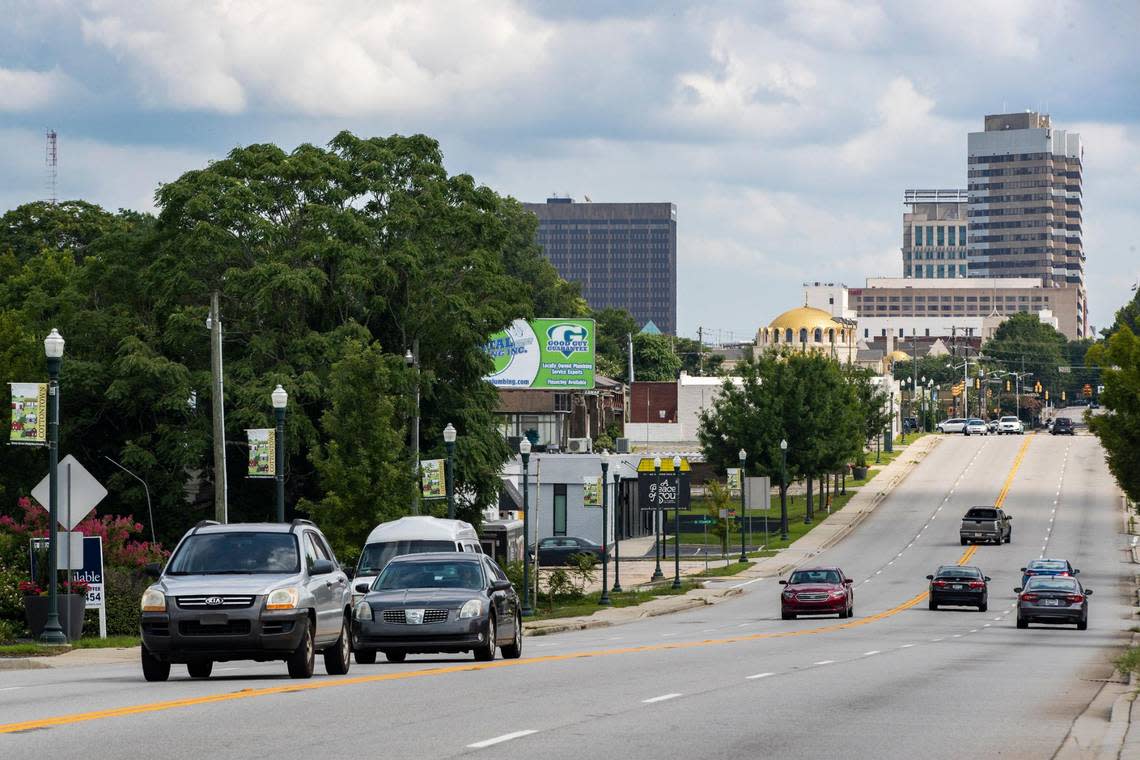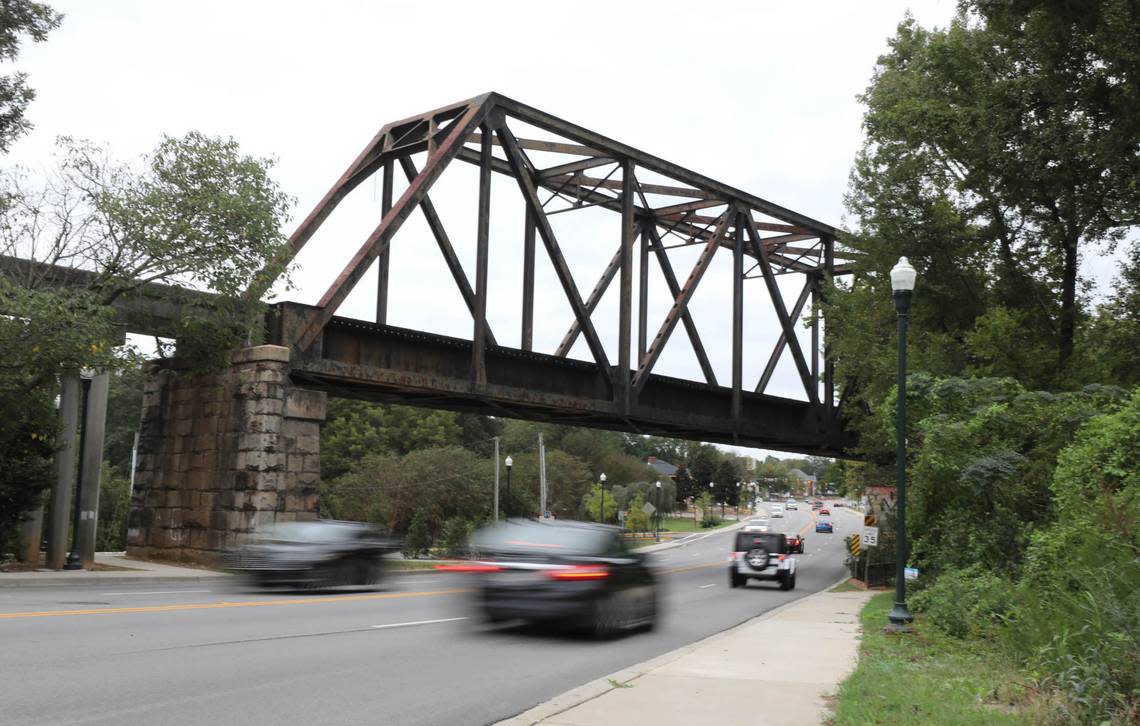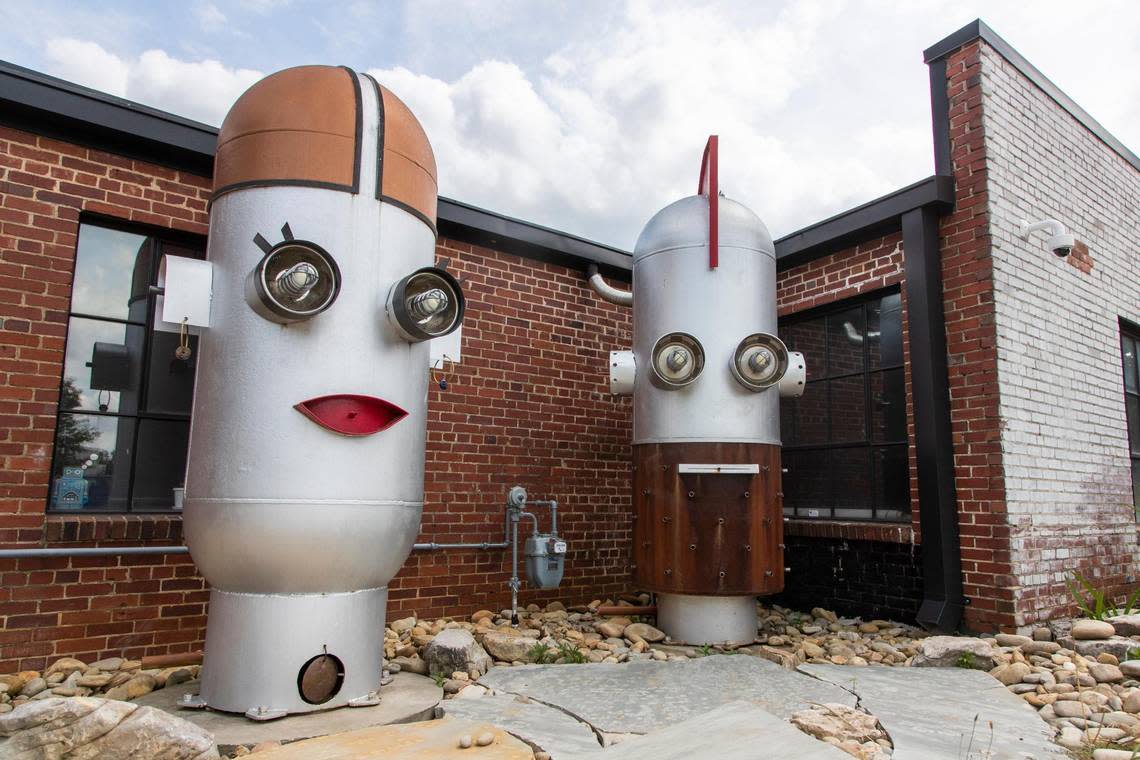As Columbia’s North Main starts to boom, can residents and development coexist?
Sabrina Odom-Edwards couldn’t slow down if she tried.
“There’s so much to see, we’re going to have to do two tours,” she exclaimed as she hurriedly got out of her vehicle and proceeded ahead, showing off all that North Main Street already has to offer.
There was a sense she’d done these rounds before, greeting each new face with excitement and familiarity. She made stops at Cromer’s Peanuts, which relocated to the area in 2018; and Carolina Imports, an antique store that moved to the famous Trestle Building just a few years before that.
She routed through the future site of the Peak Drift Brewing project, located in the former Stone Manufacturing Facility. When she arrived, another local builder, Mashburn Construction, was still hollowing the inside of the long-vacant property for use.
Main Street Bakery and the newly improved Hyatt Park were also on Odom-Edwards’ list. She drove as far as the South Carolina United soccer facilities just north of Interstate 20. A few miles away, just south of the interstate, 288 new affordable housing units called Garden Lakes Apartments will come on-line in the next few years – reportedly the first new multi-family housing project in the area in decades.
It’s an exciting time for Odom-Edwards and others who have worked to attract new development to the North Main area. After decades of minimal investment, developers are finally setting their sights north of downtown. At least three new apartments representing almost 600 new units are in-progress in the corridor, a charter school wants to expand near Elmwood Avenue, and many believe new retail is certain to follow, too.
Residents say growth is good for this long-overlooked part of Columbia, particularly in an area with no major grocery store, few schools and limited access to health care.
But new projects bring growing pains that can’t be ignored. Concerns from traffic to gentrification are intertwined with the forward march of the North Main corridor. This swath of the city — long seen as the next frontier for downtown growth — is now grappling with the push and pull of change.
A rebrand
Azalea blooms and original 1920s fixtures ultimately sold Doug Aylard 17 years ago, when he and his wife bought a house in historic Cottontown off Columbia’s North Main corridor.
The neighborhood was “artistically-minded,” Aylard remembers. Musicians lived across the street and next door, a cinematographer.
They saw the house and “30 days later we were owners,” he said.
Before they closed on the home, Aylard’s real estate agent tried to talk him out of it because she said it wasn’t the best place to raise a family. He and his wife weren’t concerned, but similar stigmas about the area have persisted.
After a few years in the neighborhood, Aylard started hearing complaints about a lack of local retail options, particularly that his neighbors were sick of drinking grocery store wine. In 2012, he started Vino Garage selling wine and beer, which opened first at 2327 Main St. and then moved up the street to 2501 Main.
It was the first new retail investment in the district in years, and many community leaders considered the opening a catalyst for the other retailers and restaurants that have followed since.
For a long time, Aylard’s customers came from his and the adjacent neighborhoods in the North Main area and not really from elsewhere.
“I wasn’t pulling any business or anyone who worked downtown because of that mentality that North Main is the Wild West,” Aylard said.
There’s a perception that anything beyond Elmwood Avenue is a bad part of town, he said.
The addition of businesses like The War Mouth and Indah Coffee have helped bring more people past the Elmwood Avenue barrier, but the gradual reputation shift hasn’t happened by accident.
All the way up Odom-Edwards’ tour route are light posts adorned with banners proudly declaring you are on North Main Street, spelling out “NOMA” in bold letters. The banners are part of a rebrand she and her organization, the North Columbia Business Association, has been working on for years.
They’ve installed security cameras around high-traffic areas, added wayfinding signs for a sense of place and successfully pressured city officials for a major streetscaping project that has already begun changing perceptions about the previously blighted corridor.
Next, Odom-Edwards hopes to get businesses to offer their employees incentives to ride The COMET bus to and from work to help create a more pedestrian-focused area.
New investment, and the growth that is sure to follow, is ultimately good for North Main Street and the people who live there, say many community leaders, including city councilwoman and North Main-area resident Tina Herbert.

“We want the development,” Herbert said. “For us to get some of the amenities that we want, we’re going to need a lot more people either way.”
But now that the perception of the area is changing, some worry what the corridor becomes won’t be in the hands of longtime residents and business owners, but instead will be at the whim of private developers taking a piecemeal approach to the outgrowth of downtown.
The impossible balancing act
When the Elmwood Park Neighborhood Association first learned more than a year ago of a new affordable housing project coming to the corner of River Drive, residents invited the developers to a community meeting.
Neighborhood leaders and other residents sat on a video call in early July 2021 while representatives for Ohio-based developer Woda Cooper answered questions about their new project – a 56-unit affordable housing complex called Benton Crossing to sit at the corner of River Drive and Benton Street.
Neighbors were concerned that a five-story building with that many apartments would dramatically change their community. They worried it would be an overbearing presence on homes and create a traffic nightmare.
And they have brought those concerns to city zoning and design approval meetings hoping to sway decision makers to reject the project. They’ve been unsuccessful. Woda Cooper has made some modifications to its designs, but the building is still set to move forward.
Despite a degree of coordination with Woda Cooper, much of the neighborhood still isn’t getting what they want.
“I think overall people are excited about development,” said John Wilkinson, president of the Elmwood Park Neighborhood Association. “Our concern is always just how is it going to be compatible with the neighborhood, mainly, quality of life in the neighborhood.”
The opposition to Benton Crossing has created a separate tension in the district. Some believe the pushback is simply because homeowners don’t want low-income renters in their neighborhood, while Elmwood residents say they would welcome affordable housing, just on a smaller scale.
Another development on the horizon, the proposed Clear Dot Charter School campus off Elmwood Avenue, has also been ill-received by some who worry about increased traffic and decreased property values.
This is the impossible question, leaders say, and an inevitable growing pain when an area finally starts to see new investment. There will be some “Not in my backyard”-isms. There will also be legitimate concerns from property owners about the future of the neighborhoods they invested in when they bought their homes.

You can’t give everyone what they want, Odom-Edwards said. But you still need to strive to understand what the varying concerns may be.
“You don’t want to be a place of ‘no’” she said.
Getting every neighbor to sign off on a project is “idealistic,” Herbert added. But she said a community’s response can dictate whether a new project survives in an area.
Herbert added it is still crucial to find creative ways to maintain the existing community character, but city government is limited in how much it can intercede.
One of Herbert’s ideas is to create a tax assistance pool for older residents of a certain income to help if and when property taxes increase in the area.
“As long as you stay mindful of the fact that you do need to balance all of the interests, then you’re at least starting in the right place,” Herbert said.
Government involvement
Not everyone is optimistic about the influx of investment coming to North Main Street.
J.T. McLawhorn, a former urban planner and president of the Columbia Urban League, said he’s seen this film before.
“When you have these developments … the people who live in those areas for years don’t benefit at all from those public investments,” McLawhorn said. “It’s the same old language, over and over again. ‘We’re going to improve your community. We’re going to enhance the quality of life for the residents in this area.’ But what is left out is when they’re finished, it’s not your community anymore.”
Residents need to be prioritized first, he said, particularly in the parts of the North Main corridor that have more low-income and minority residents.
The share of Black residents in neighborhoods like Elmwood Park and Cottontown is already declining. In 2010, 27% of residents in the census tract containing those two neighborhoods were Black. By 2020, that number fell to just below 19%, according to Census Bureau data.
The same pattern can be seen just slightly north in the Earlewood neighborhood, where between 2010 and 2020 the Black population in that census tract fell by nearly 24%.
McLawhorn, whose office sits right across North Main from Odom-Edwards’, believes it is the city’s responsibility to mandate cooperation between developers and residents so that more people don’t feel forced to leave, at least when a project benefits from public dollars or tax credits.
“You have to look at it piece by piece, what it’s going to mean,” for residents and existing businesses McLawhorn said. Developers need to listen to whether a new project is going to create traffic problems or make it harder for residents to access different services, he said.
That philosophy is shared by national experts who study ways to responsibly revitalize minority communities.
“I have observed economic development happen to the community instead of with the community,” said Dawn Deck, director of the Local Initiatives Support Corporation of Upstate South Carolina, an organization with offices nationwide working to redevelop historically under-resourced communities.
Deck said local residents need to be among the decision-makers when new investment comes to town. She also noted research LISC’s national office has recently conducted with the Brookings Institute to study this exact issue. That research shows gentrification happens when growth comes through attracting outside investment, rather than building up existing entrepreneurs.
To avoid the typical pitfalls, they suggest a handful of strategies that leave more control with residents. They include creating capital for local entrepreneurs and establishing strong neighborhood systems. In both regards, Columbia has already seen some success.
Between 2011 and 2012, the city spent more than $425,000 and tapped $6 million in private funds for a grant program to help local entrepreneurs and existing businesses improve their storefronts.
Herbert helped run that program when she led the city’s Office of Business Opportunities and partially credits it with the current vitality of downtown.
The effort gave local entrepreneurs up to $20,000 in forgivable loans in the downtown business district as long as they matched a portion of the grant and stayed at the same location for three to five years.
The city gave the grants almost exclusively to local business owners – the intention being to foster locally-grown enterprises that would remain invested in the outcome of the area.
Herbert said she believes a similar program could be replicated in the North Main corridor, if the city can find the money. She added it would also give the city more input about which projects thrive, and how they’re built.
“The great thing about programs like that is you really can design the program to attract exactly what you want to attract,” she said. For example, the city could build a program specifically to incentivize grocery stores — which are sorely missing across much of north Columbia.
“I think we want to preserve as much as we can, but we have to manage that dynamic of preserving and growing,” Herbert said.
Inevitable change
Aylard has already noticed some changes on his Cottontown block. There are more retirees and more short-term rentals, for example. But he doesn’t feel like the character of the area is in immediate jeopardy.

As a resident, he’s admittedly trepidatious about the proposed Clear Dot Charter School expansion. But as a business owner, he’s thrilled at the prospect for new housing and new customers.
One way or the other, development will come, he said.
He still loves his neighbors; he still recognizes most of his customers and is taken slightly aback when someone’s 3-year-old is suddenly 14. He still gets to watch his community grow up, and he doesn’t see that changing in the near future.
“The only inevitable thing in life is change. If a development is well-thought out and there’s a market for it, then it’ll stay,” Aylard said. “Business owners and landlords just have to be careful with what businesses they choose to put somewhere.”
That is where Odom-Edwards, the North Columbia Business Association and the various neighborhood associations in the North Main area are trying to steer the ship. Odom-Edwards said sometimes they will be successful, and sometimes there will be setbacks.
“You’re always going to have people who disagree, and that’s why economic development anywhere is really tricky,” she said. “But we’re very excited for all the development because it can bring jobs. It can bring convenience. It could bring businesses and that means more people can afford to live here. I think we all can play a part in that.”
